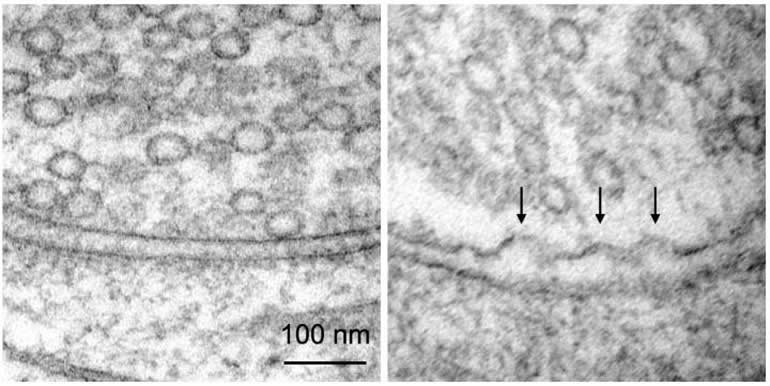Thursday, 1 April 2021
The incredible speed of synaptic transmission

Sometimes you think you know all about a subject because you’ve been making presentations about it for years, or even decades. But then you read one article that makes you realize just how much you didn’t know. That’s what just happened to me. The subject was synaptic transmission, and the article was Synaptic vesicles transiently dock to refill release sites, published in the journal Nature Neuroscience in September 2020. The principal authors of this study, Grant F. Kusick and Shigeki Watanabe of the Johns Hopkins University School of Medicine in the United States, used a cell-imaging technique called “zap-and-freeze” to analyze how neurons release neurotransmitters into synapses. What these authors specifically wanted to understand was how the synaptic vesicles near the tip of an axon (the synaptic button), which fuse with its plasma membrane to release neurotransmitters into the synaptic gap, subsequently form again so that the neuron can be ready to handle the next nerve impulse. Because several tens or even several hundreds of nerve impulses can all arrive at the same synaptic button at one time, the authors reasoned, these vesicles must re-form extremely rapidly for there to be enough of them ready to release neurotransmitters again as soon as the next impulse arrives.
Before this study, no one had ever been able to visually observe the ultra-rapid dynamic by which synaptic vesicles fuse with the membrane and release their neurotransmitters and the pool of synaptic vesicles ready to release neurotransmitters is then reconstituted. That is what Kusick and Watanabe did. Using the “zap-and-freeze” technique, they electrically stimulated neurons in vitro and froze them a precise number of milliseconds later, thus taking a “snapshot” that they could observe with an electron microscope, the only instrument capable of seeing something as small the synaptic vesicles of a neuron (see the image at the start of this post).
The speed of the phenomena captured by the photos from this study is, of course, astounding. But more important is that the details that they reveal about the various phases of these phenomena have greatly enriched scientific understanding of synaptic transmission. These photos show that at any given time, there are only a few vesicles that are actually “docked”: lined up close to the axon’s terminal button membrane and ready to fuse with it when a nerve impulse arrives. Immediately after the impulse arrives, the number of docked vesicles decreases by 40%. Thus, if no other mechanism came into play, the stock of docked vesicles ready to fuse would be almost exhausted after 2 to 3 impulses.
In reality, however, these photos show, as little as 14 milliseconds after an impulse arrives, new vesicles are recruited and fully replenish the docked pool. But this docking is transient. Within 100 milliseconds (a tenth of a second) at most, these vesicles will either move away from the membrane (undock) or fuse with it in turn. These findings just how fast and flexible synaptic transmission is.
And as I stated above, this fusion and re-forming of synaptic vesicles occurs tens or even hundreds of times per second, in thousands and thousands of neurons that connect to thousands of others among the 86 billion in your brain. Note to self: from now on, whenever you give a live talk and cover this aspect of synaptic transmission, pause for a few seconds to give your audience time to take in the sheer speed and complexity of the phenomena involved!
From the Simple to the Complex | Comments Closed







